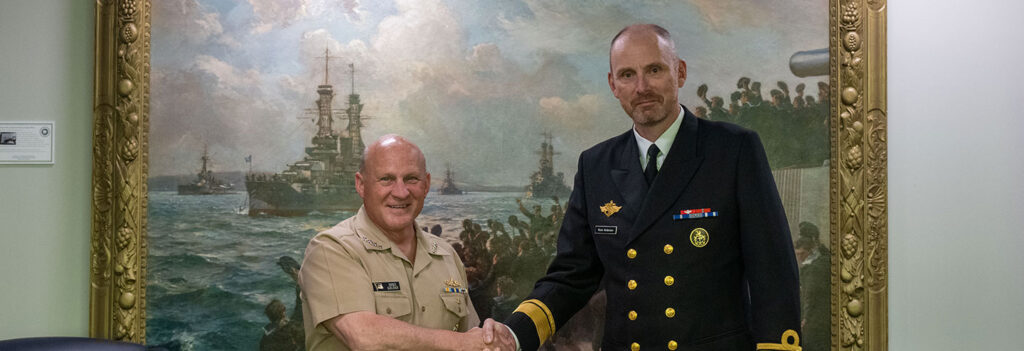Then-Chief of Naval Operations Adm. Michael Gilday, left, meets with Chief of the Royal Norwegian Navy Rear Adm. Rune Andersen at the Pentagon, on June 29, 2023. The leaders discussed the maritime domain, regional security and stability, and the importance of the Arctic. SPECIALIST 1ST CLASS MICHAEL B. ZINGARO/U.S. NAVY
THE WATCH STAFF
Norway will increase its interoperability with NATO forces by integrating its Norwegian Joint Headquarters (NJHQ) operations into NATO’s Allied Joint Force Command Norfolk (JFC Norfolk), which is based in Virginia. Western allies view this as crucial to defending the North Atlantic, as well as Arctic supply lines and sea lanes. This follows discussions between senior U.S. and Norwegian military officials on the sidelines of the July 2023 NATO summit in Vilnius, Lithuania.
The NJHQ has overall command and control over military activities in Norway and in the country’s missions abroad, carries out large military exercises, and advises the defense minister.
JFC Norfolk was established in 2019 and attained full operational capability in 2021. At the opening ceremony aboard the USS Kearsarge, then-Commander Andrew Lewis said the JFC sent a strong signal of NATO’s commitment to its common defense, saying, “The security environment continues to grow more challenging and complex — particularly in the Atlantic. JFC Norfolk demonstrates NATO’s dedication to security and stability in the region and sends a strong message of reassurance to both North Americans and Europeans, while serving as a powerful signal to deter any potential adversary.”
Vice Adm. Rune Andersen recently assumed command of the Norwegian Joint Headquarters in the country’s Arctic city of Bodø in late November 2023. A senior U.S. military official attended the change-of-command ceremony and praised Norway’s readiness to preserve an Arctic resupply link and defend northern Europe if NATO is challenged.
Anderson said his country’s defense posture changed considerably in the past few years as Russia has stepped up aggressive activities in the Arctic and invaded Ukraine in 2022.
“A lot has happened both at home and abroad in the past years; we have withdrawn from Afghanistan, the war in Ukraine broke out, and we have increased preparedness at home and in the sea areas,” Anderson told the High North News, a newspaper published by the High North Center at Nord University in Norway.
“It is hard to predict what will happen going forward. We must be prepared to handle situations with short notice. And that also underlines the significance of good relations between the actors in the total defense, and in NATO,” Anderson said.
Norwegian Defense Minister Eirik Kristoffersen advanced the plan to move a NATO command to Bodø this year. As plans for the new joint command coalesce, Norway will continue to evaluate the role of its joint headquarters, he said.
“The Nordic countries have looked at how we can avoid duplications and how we can get the most out of the forces and headquarters we have. In this work, we have not reached a conclusion yet,” Kristoffersen said.
Norway’s defense budget is set to rise from $8.2 billion to an imposing $20.8 billion, according to GlobalData, an analytics and consulting firm based in London. Much of that spending is being funneled to the country’s Arctic defenses as well as upgrading its air force with F-35s and replacing aging tanks, naval vessels and other hardware, the firm reported.
U.S. Vice Adm. Daniel Dwyer, commander of NATO’s JFC Norfolk, who attended the Bodø ceremony, said Norway’s Joint Headquarters is a valuable partner in NATO defense and helps fulfill a key part of Norway’s NATO mission.
“The trans-Atlantic link is key in ensuring that NATO is resupplied and reinforced from North America,” Dwyer told the High North News, saying that trans-Atlantic links remain secure only if the Arctic region remains free and unimpeded by efforts to undermine the rules-based international order.
“That is why working with Norway, Finland and our partner Sweden, we can work alongside each other to better understand the challenges in the Arctic and inform our decisions on force structure and military equipment to ensure that we can operate in the region.”

